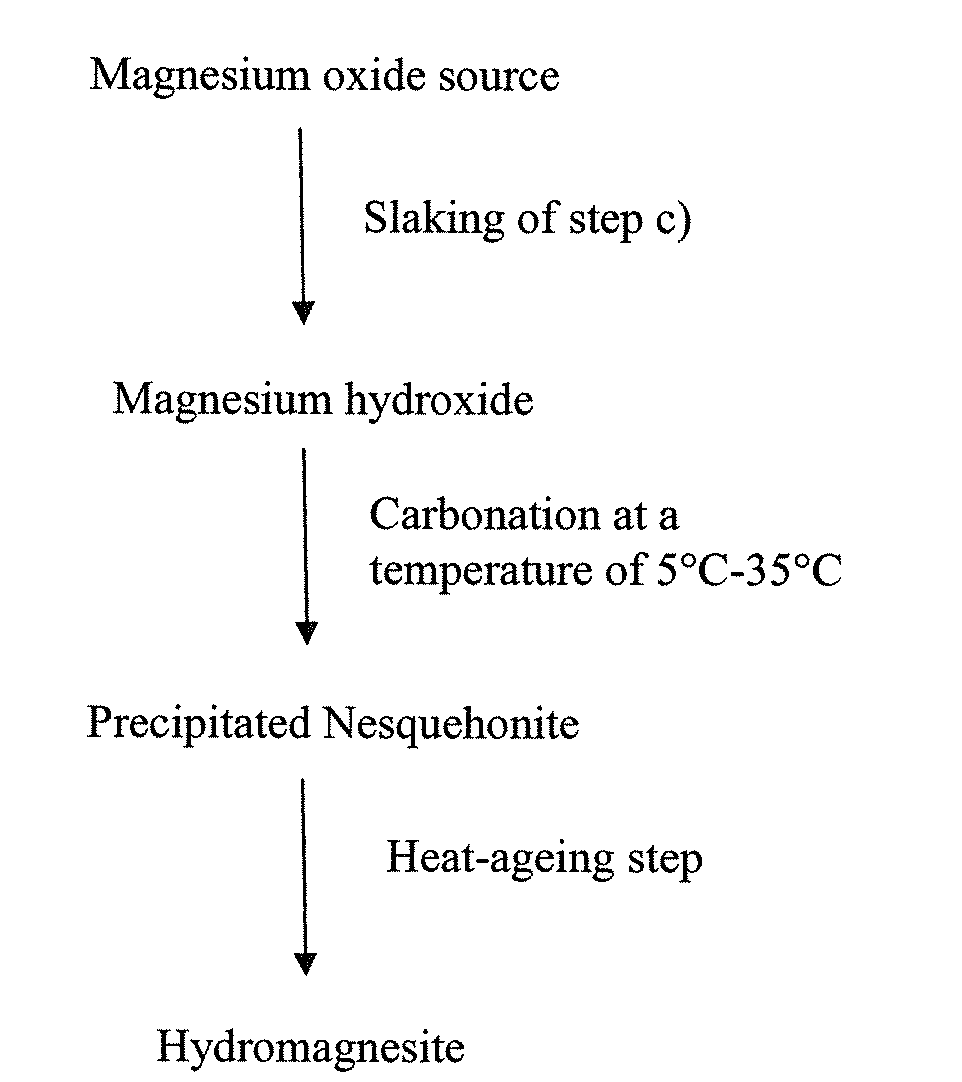Precipitated magnesium carbonate
a magnesium carbonate and precipitation technology, applied in the field of pre, can solve the problems of inability to meet the physical and optical properties of the obtained products, inability to mechanically comminution particles is usually not a suitable and effective method, and inability to achieve satisfactory physical and optical properties, etc., to achieve the effect of improving optical properties, reducing particle size, and high degree of whiteness
- Summary
- Abstract
- Description
- Claims
- Application Information
AI Technical Summary
Benefits of technology
Problems solved by technology
Method used
Image
Examples
examples
Measurement Methods
[0169]The following measurement methods are used to evaluate the parameters given in the examples and claims.
Brookfield Viscosity
[0170]The Brookfield-viscosity of a slurry was determined with a Brookfield Viscometer type RVT equipped with a LV-3 spindle at a speed of 100 rpm and room temperature (20±3° C.).
BET Specific Surface Area of a Material
[0171]The BET specific surface area is measured via the BET method according to ISO 4652 using nitrogen, following conditioning of the sample by heating at 250° C. for a period of 30 minutes. Prior to such measurements, the sample is filtered, rinsed and dried at 110° C. in an oven for at least 12 hours.
Particle Size Distribution (Mass % Particles with a Size 50) of a Particulate Material
[0172]The average particle size and the average particle size mass distribution of a particulate material are determined via laser diffraction, i.e. the light from a laser passes though a suspension and the particle size distribution is cal...
example 1
[0179]The following illustrative example of the invention involves the preparation of hydromagnesite by slaking caustic calcined magnesite and contacting the obtained magnesium hydroxide with gaseous CO2 to convert the obtained magnesium hydroxide into hydromagnesite, wherein the carbonation is carried out with a starting temperature of about 20° C. to 25° C. and a subsequent heat-aging step.
[0180]90 kg of caustic calcined magnesite (Van Mannekus M95) were slaked by adding said magnesite to 1 700 liters of 40° C. tap water in a stirred reactor. The magnesite was slaked for 15 min under continuous stirring and the resulting suspension was adjusted to about 5% solids content via dilution with water. The carbonation was conducted in a 1800 liter baffled cylindrical stainless steel reactor equipped with a gassing agitator, a stainless steel carbonation tube to direct a carbon dioxide / air gas stream to the impeller and probes for monitoring the pH and conductivity of the suspension. The ...
example 2
[0181]The following illustrative example of the invention involves the preparation of hydromagnesite by calcining and slaking white dolomite stone and contacting the obtained magnesium hydroxide with gaseous CO2 to convert the obtained magnesium hydroxide into hydromagnesite, wherein the carbonation is carried out with a starting temperature of about 12° C. and a subsequent aging step.
[0182]White Dolomite stones (Hammerfall A / S) were crushed to yield a grain size of 10-50 mm and calcined in a rotary kiln at 1050° C. for 60 min. The resulting burned Dolomite (CaO.MgO) was ground in a ball mill to obtain a powder with mean particle size of about 40 μm (CILAS laser diffraction method).
[0183]200 kg of said burned Dolomite were slaked by adding to 1 000 liters of 50° C. tap water in a stirred reactor. The burned Dolomite was slaked for 30 min under continuous stirring and the resulting suspension was adjusted to about 8% solids content via dilution with water. The carbonation was conduct...
PUM
| Property | Measurement | Unit |
|---|---|---|
| particle size d50 | aaaaa | aaaaa |
| temperature | aaaaa | aaaaa |
| temperature | aaaaa | aaaaa |
Abstract
Description
Claims
Application Information
 Login to View More
Login to View More - R&D
- Intellectual Property
- Life Sciences
- Materials
- Tech Scout
- Unparalleled Data Quality
- Higher Quality Content
- 60% Fewer Hallucinations
Browse by: Latest US Patents, China's latest patents, Technical Efficacy Thesaurus, Application Domain, Technology Topic, Popular Technical Reports.
© 2025 PatSnap. All rights reserved.Legal|Privacy policy|Modern Slavery Act Transparency Statement|Sitemap|About US| Contact US: help@patsnap.com

